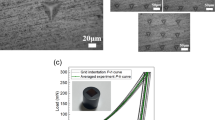Abstract
The high-temperature flow behavior of Sn-5Sb lead-free solder alloy has been investigated using isothermal hot compression experiments at 298 K to 400 K and strain rate between 0.0005 s−1 and 0.01 s−1. The flow stress under these test conditions was modeled using constitutive equations based on the Johnson–Cook (J–C) model and an artificial neural network (ANN). Three input factors, i.e., temperature, strain rate, and true strain, were incorporated into the network, and the flow stress was considered as the system output. One hidden layer was adopted in the simulations. Furthermore, a comparative study was carried out on the potential of the two proposed models to characterize the high-temperature flow behavior of this alloy. The capability of the models was assessed by comparing the simulation predictions using a correlation coefficient (R 2). The stresses predicted by both models presented good agreement with experimental results. In addition, it was found that the ANN model could predict the high-temperature deformation more precisely over the whole temperature and strain rate ranges. However, this is strongly dependent on the availability of extensive, high-quality data and characteristic variables.
Similar content being viewed by others
References
M.J. Esfandyarpour and R. Mahmudi, Mater. Sci. Eng. A 402, 530 (2011).
A.A. El-Daly, A. Fawzy, A.Z. Mohamad, and A.M. El-Taher, J. Alloys Compd. 4574, 509 (2011).
A.A. El-Daly, A.Z. Mohamad, A. Fawzy, and A.M. El-Taher, Mater. Sci. Eng. A 1055, 528 (2011).
R. Mahmudi, R. Alizadeh, and A.R. Geranmayeh, Scr. Mater. 521, 64 (2011).
E. Karaköse, M. Fatih Kılıçaslan, and H. çolak, J. Alloys Compd. 378, 655 (2016).
L. Benvenuti, C. Kloss, and S. Pirker, Powder Technol. 456, 291 (2016).
T.D. Dongale, P.R. Jadhav, G.J. Navathe, J.H. Kim, M.M. Karanjkar, and P.S. Patil, Mater. Sci. Semicond. Process. 43, 36 (2015).
J. Zhang, Q. Feng, S. Wang, X. Zhang, and S. Wang, J. Supercrit. Fluids 31, 107 (2016).
M. Jiang, C. Ma, F. Xia, and Y. Zhang, Surf. Coat. Technol. 191, 286 (2016).
A. Banerjee, S. Dhar, S. Acharyya, D. Datta, and N. Nayak, Mater. Sci. Eng. A 200, 640 (2015).
L. Gambirasio and E. Rizzi, Mater. Sci. Eng. A 370, 610 (2014).
A. He, G. Xie, H. Zhang, and X. Wang, Mater. Des. 677, 52 (2013).
J. Kennedy and R. Eberhart, in Proceedings, IEEE International Conference on Neural Networks (1995)
Z. Liu, J. Lu, and P. Zhu, Compos. Struct. 630, 140 (2016).
M. Rahman, S. Anwar, and A. Izadian, J Power Sources 86, 307 (2016).
Z. HuiRuan, Y. Yuan, X. Zhang, Y. Shuai, and H. Tan, Sol. Energy. 147, 127 (2016).
G. Semwal and V. Rastogi, Opt. Commun. 336, 359 (2016).
Y. Dong, C. Zhang, G. Zhao, Y. Guan, A. Gao, and W. Sun, Mater. Des. 983, 92 (2016).
Z. Du, S. Jiang, and K. Zhang, Mater. Des. 464, 86 (2015).
Y. Sun, Z. Wan, L. Hu, and J. Ren, Mater. Des. 922, 86 (2015).
F. Yang and J. C. M. Li, Lead-Free Electronic Solders: A Special Issue of the J. Mater. Sci.: Mater. Electron. 191, 25 (2007)
M.D. Mathew, H. Yang, S. Movva, and K.L. Murty, Metall. Mater. Trans. A 99, 36 (2005).
Author information
Authors and Affiliations
Corresponding author
Rights and permissions
About this article
Cite this article
Vafaeenezhad, H., Seyedein, S.H., Aboutalebi, M.R. et al. Incorporating the Johnson–Cook Constitutive Model and a Soft Computational Approach for Predicting the High-Temperature Flow Behavior of Sn-5Sb Solder Alloy: A Comparative Study for Processing Map Development. J. Electron. Mater. 46, 467–477 (2017). https://doi.org/10.1007/s11664-016-4887-5
Received:
Accepted:
Published:
Issue Date:
DOI: https://doi.org/10.1007/s11664-016-4887-5




